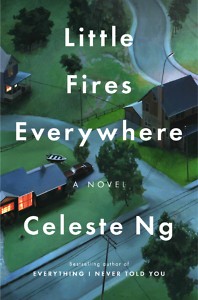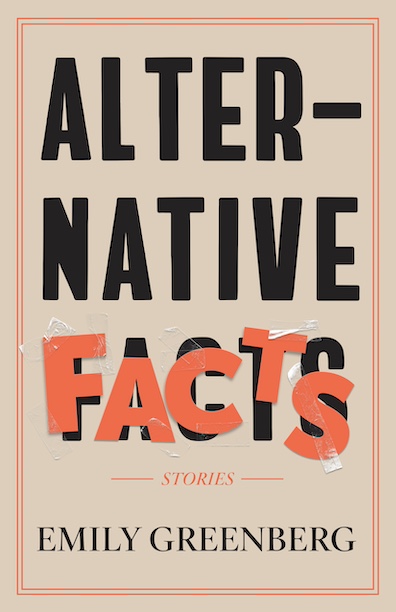Some of Them Burn
Planned community and contested motherhood collide in Celeste Ng’s Little Fires Everywhere
“Later people would say that the signs had been there all along,” says the narrator of Celeste Ng’s evocative new novel, Little Fires Everywhere in the book’s opening paragraph. These signs would indicate something amiss with the Richardson family, whose house and all six of its bedrooms are ablaze as the book opens. Hindsight for nosy neighbors may be 20/20, but as the book’s numerous narratives shake out in messy and unexpected ways, we begin to notice that the signs—or some of them, at least—really had been there all along.

Within seven pages, we know what the little fires of the title are, who set them, and the result. We know that Izzy, the youngest and most free-spirited Richardson daughter, is the prime suspect. We know that Mia Warren and her fifteen-year-old daughter, who had been renting half a duplex the Richardsons own across town, have turned in their keys and are gone. And while it comes in a seemingly casual aside, we know the basic outline of the conflict that will spring the trap of the custody battle at the novel’s center: “All spring the gossip had been about little Mirabelle McCullough—or, depending which side you were on, May Ling Chow.”
What we don’t know is how these elements connect to each other. Ostensibly a series of interlocking flashbacks that eventually loop back to day of the fire, Little Fires Everywhere begins where it ends—encompassing several lifetimes’ worth of aspiration and loss along the way. As in Ng’s heartrending debut, Everything I Never Told You, private histories surface in alternating vignettes. But where Everything focuses primarily on one family, Little Fires encompasses a wider cross section of the cloistered community where it’s set.
Shaker Heights, the narrator tells us, is a supremely orderly place, one designed in a highly particular way: “There were rules, many rules, about what you could and could not do.” The rules include a palette of acceptable colors for a house’s exterior paint and duplexes built to look from the street like single-family homes—a way to disguise the fact that there are renters, not homeowners, who live there. Shaker Heights is like Stepford but with well-intentioned white liberalism as its animating force.
Elena Richardson is a middle-aged cub reporter who never left the den of the local small-town newspaper. (As in Everything I Never Told You, a dreamed-of career stymied by traditional gender roles works here as a capacitor of submerged resentment.) Wife to BMW-driving attorney William and mother of four, Elena embodies the manicured progressivism of Shaker Heights. Thrifty, resourceful Mia, who rolls into town with her teenage daughter, Pearl, is an artist forever chasing her muses, working odd jobs in new towns on a rolling basis, uprooting every time she finishes a cycle of photographs and sends them off to her gallerist in New York. If not exactly Elena’s foil, Mia is a woman who has lived in the world differently, led by her own vision.
 The two families, so different in their levels of wealth and material comfort, become enmeshed in each other’s lives, and a complicated set of allegiances develops as the battle over Mirabelle/May Ling grips the town’s attention. To say much more risks spoiling the way the plot develops—and it develops slowly, at first. Teens awkwardly engage and avoid each other amid the ennui of suburbia’s scrubbed surfaces. Crushes develop. Secrets, too. The early chapters project the atmosphere of a YA novel at times, but if that seems off-putting at all, bear with it. This immersion in the usual rhythms of Shaker Heights is crucial for establishing the backdrop of Elena and Mia’s falling out, and of everything that eventually fuels all those little fires. Once set in motion, the plot and its converging backstories twist and crackle with breathtaking urgency.
The two families, so different in their levels of wealth and material comfort, become enmeshed in each other’s lives, and a complicated set of allegiances develops as the battle over Mirabelle/May Ling grips the town’s attention. To say much more risks spoiling the way the plot develops—and it develops slowly, at first. Teens awkwardly engage and avoid each other amid the ennui of suburbia’s scrubbed surfaces. Crushes develop. Secrets, too. The early chapters project the atmosphere of a YA novel at times, but if that seems off-putting at all, bear with it. This immersion in the usual rhythms of Shaker Heights is crucial for establishing the backdrop of Elena and Mia’s falling out, and of everything that eventually fuels all those little fires. Once set in motion, the plot and its converging backstories twist and crackle with breathtaking urgency.
But as deftly as she diagrams the deepening complications of her characters’ lives, Ng is as good, if not better, in the details: how the mechanics of pregnancy tests differ by decade, for instance; the ingenious methods Mia employs for making her art; how an attorney sets up a witness with a line of questioning that ends in a declaration that white people are the “default,” even though she probably wouldn’t have phrased it that way had she been asked directly. Ng also skillfully weaves questions of identity and representation into the transracial adoption story—the default whiteness here refers to dolls and storybooks—and she’s careful to consider how both the Chinese-born birth mother and her Chinese-American attorney are portrayed in the media.
And the novel complicates our ideas of right and wrong in nuanced ways. A character who is outwardly pro-choice pursues an angle that relies on the stigma of abortion for its bite. One mother abandons her child because she feels she has no choice; another refuses to give up her child for the same reason. We are forced to reckon with the questions of who “deserves” to raise a child and whether affluence carries too much weight when these decisions are made. Even the character arguably responsible for causing the most harm in the book comes across as complex and human. We are invited to admire her intellect, her tenacity, her loyalty to friends—even as we recoil from her ruthlessness.
All these conflicts sit against the backdrop of the place itself. Shaker Heights is a town built on the idea of progress—tidy, efficient, top-down progress. And it seems to be choking on its own idealism. “Did you have to burn down the old to make way for the new?” one character asks. The answer, like this richly imagined novel itself, is anything but simple.
 Steve Haruch lives in Nashville. His work has appeared at NPR’s Code Switch and in The New York Times. He is the editor of People Only Die of Love in Movies: Film Writing by Jim Ridley (Vanderbilt University Press, 2018).
Steve Haruch lives in Nashville. His work has appeared at NPR’s Code Switch and in The New York Times. He is the editor of People Only Die of Love in Movies: Film Writing by Jim Ridley (Vanderbilt University Press, 2018).


